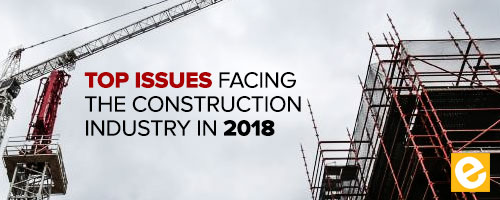
The Top Issues Facing Construction in 2018
Several industry surveys and reports forecast continued growth in the construction industry. Albeit, the growth shows a modest 4.8% increase, different from the double-digit growth in previous years. Regardless, there is still a general sense of optimism. With continued growth and positive outlook in the construction industry, what can possible be keeping construction executives up at night? Below, I touch on the top issues facing the construction industry in 2018.
1. Unpaid work
Of course, finances are one of the major issues that keep construction executives up at night. With a responsibility to ensure the livelihood of their employees and their families, it is important to have positive cash flow for the company. Unfortunately, subcontractors are not receiving payment for their completed work in numerous instances. Subcontractors have filed claims against their general contractors and owners in several major projects. Contractors claim $11 million in unpaid work at Kings’ downtown hotel project. Another $11 million has been unpaid in the Astros Nationals ballpark project, and $3 million is still unpaid at Disney. These are just the stories that made the news. Subcontractors are front-loading costs on many projects and paid their suppliers and employees. However, they are patiently awaiting payment from the General Contractor or owner who may be disputing the payments although the work is completed.
The General Contractor in the dispute with subs on Disney work stated, “Simply billing for work is no proof work was ever done.” Subcontractors need to develop thorough best practices to prevent putting themselves in similar scenarios. Photos and notes provide visual documentation of any jobsite issues that need to be addressed or rework that may be needed. Foreman must document any delays, disruptions and lost hours. Additional documentation including signed approvals on submittals, change orders, etc. serve as irrefutable proof to receive any payment on claims.
2. Retirement of aging boomers
Across the nation, thousands of baby boomers are retiring per day. This is a troublesome statistic considering that 54% of construction managers are boomers. With them leaves the requisite knowledge and experience that they have gained over their career. Construction executives must figure out how to transfer all of that knowledge to a new batch of hires in a time of labor shortage.
Many trades are also attending high school career fairs to proclaim construction as a desirable profession. Through active outreach, many construction companies are improving recruitment into the trades. Several construction companies are developing a mentorship program to bridge the knowledge gap between baby boomers and younger workers.
3. Varied technology among General Contractors
For every general contractor that incorporates new technology, they provide access to their subcontractors to use the same technology for collaboration. However, subcontractors work with multiple general contractors who may all different software. Subcontractors can become overwhelmed learning multiple solutions to meet requirements of their general contractors.
This arrangement benefits the General Contractor and not the subcontractors. When subcontractors use their general contractor’s project management solutions, this can put them at a disadvantage. The GC owns the system and its documentation. In the event of a claim or dispute, the General Contractor can and will likely revoke access to the subcontractor and edit any information as they deem fit. While it may create additional work for your team, subcontractors must maintain their own document management system to protect themselves in a dispute.
4. Unfavorable contract terms
Construction projects inherently assume a lot of financial risk. Disjointed interests shift a large amount of risk on subcontractor. In increasing numbers, subcontractors are receiving contracts with unfavorable terms such as liquidated damages, consequential impacts, warranty coverage, etc. During a recent eSUB construction webinar on risk mitigation, 86% of respondents indicated they had received a contract with liquidated damages. Any missed deadlines will directly hit your pocketbook.
However, many subcontractors experience delays that may be due to no fault of their own or unforeseen circumstances. Documentation tracking lost hours, schedule changes, any delays or disruptions is the key to protection against liquidated damages.
5. Safety
Construction work is inherently dangerous which makes insurance and workers compensation costly expenditure. 71% of respondents in a risk mitigation webinar stated they had experienced a safety incident or injury in the last 12 months. Stricter punishments are being enforced against companies that are accused of negligence. In addition to financial penalties, some construction company’s owners and/or their foreman are being convicted of manslaughter. Some receive community service or probation. However, in one instance, the judge sentenced the foreman to prison.
Unsafe practices jeopardize the safety of employees and carry severe penalties. Contractors can mitigate risk and ensure their teams follow required safety procedures. Completing safety meeting forms and inspection checklists become important to ensure that your company has gone through the requisite measures to follow safety standards. This will help mitigate any risk that any incident will take place and additionally provide documentation to remove your firm from any negligence.
6. Project delays
Unforeseen jobsite conditions. Changing scope. Design rework. All of this leads to project delays with only 25% of projects coming within 10% of original deadlines. Subcontractors attribute delays and change orders to design-induced rework and changes in scope. Companies submit project proposals based on the availability of resources. Therefore, delayed projects will cause a kink in the entire scheduling and resource management of a construction company.
With cost and schedule overruns becoming the norm in construction, the integrated project delivery (IPD) is gaining traction. IPD brings together the owner, architect, general contractor and major subcontractors at the beginning of the project to collaborate on designs, schedules, and costs. Because subcontractors perform the majority of labor on commercial projects, aligning their interests with the owner and designer creates a streamlined integrated labor delivery method. Subcontractors serve as the subject matter experts, who are responsible for the articulation of the intricate and complex designs and need a seat at the design table to ensure a building is built as intended. A project based on an integrated labor delivery model connects all the stakeholders to improve communications, accountability, and productivity.
Guest content provided by eSub Construction Software.





